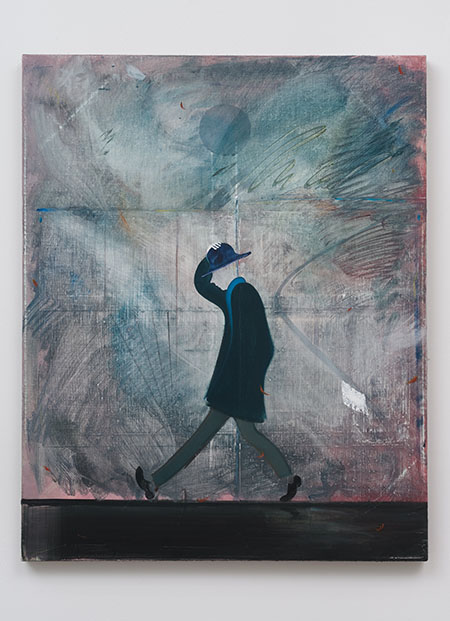Sanya Kantarovsky

In Sanya Kantarovsky’s painting Events (2012), a kneeling figure clutches his head and grasps a sheet of paper. The unfortunate conductor in Sinfonia #2 (2012) is frozen in horror as a gust of wind sends his music flying about his head. An empty table and chair awaits the protagonist in A New Talented Writer, while the man from An Episode from History (both 2012) smokes at his desk, gazing into the distance and hoping for inspiration.
If the blank page seems to terrorize the figures in many of his paintings, there is little indication that it unduly bothers Kantarovsky himself, who approaches his canvases with fluid assuredness. The prolific Russian-born, Los Angeles-based artist is apparently less afflicted by creative block as he is troubled by the ontological slipperiness of the page. Is it first and foremost a physical support for signs, for language? Is it an imaginative space for narrative illustration? Or is it a ground for experimental formalist abstraction? In Kantarovsky’s work, it is sometimes all of these at once.
In paintings such as Notnow (2012) and A New Talented Writer, rectangular planes pile over rectangular planes, all of which float on their raw linen grounds like photographs in a tray of developing solution. Abstract, flat planes threaten to spring into taut and three-dimensional figuration, while figures, assembled from swooping curves and silhouettes, lie as smoothly as snipped paper shapes. In Notnow, the foreground is occupied by a panel resembling an unfinished Christopher Wool painting; a semi-circle overlapping one edge and a weird, moustachioed disc behind suggests a comical figure proffering the quasi-Wool to the viewer.
The wonderfully odd Notnow was in fact an aberration in this exhibition, which shared its title with ‘Blue Notebook Nº 10’ (1937), a poem by the Soviet absurdist writer Daniil Kharms. All the other paintings presented their figurative elements much more straightforwardly, adhering to a nostalgic aesthetic that Kantarovsky has made his own but which alludes to both the elegance of Jazz Age New Yorker magazine covers as well as the graphic style of 1930s Soviet illustration. The Man with the Black Coat (2012), for example, shows two jackbooted silhouettes ominously flanking a man in pyjamas, his pipe slipping from his hand. The scene captures an instantly legible (though incomplete) passage of narrative, which like most of the show was inspired by Kharms’ life and work: the subversive writer was eventually executed by the Soviet authorities.
That may be about as political as Kantarovsky gets here. Broadly, his tone is endearingly wistful, as if cold hard history had thawed to the gentler, well-rounded and familiar shapes of its own retelling. Doors and windows recur as motifs throughout, representing not only portals for imaginative escape but also the 20th century’s competing symbols for the pictorial status of the canvas. One of three powder-coated steel sculptures in the centre of the gallery is titled Shabolovka (2012); the title refers to the area of Moscow in which Kantarovsky grew up. It consists of two oval frames, hinged at the middle, one empty and the other filled by a decorative metal grille based on one that covered a window in his kindergarten. (Can he really remember it so clearly?) The frames are apertures, one obstinately blocked and the other waiting to be stepped through.
A two-screen video installation, Before 16 and Older (2012), was a first for the artist, and perhaps a less satisfying translation of his well-established pictorial and sculptural language. This may be to do with tone or atmosphere; while Kantarovsky’s cool palette and refined stylistic inflections transport us to a distant (though convincing) geographical and imaginative realm, a softly lit studio shot of curling sheets of paper and, on an adjacent monitor, a boy running along a desert road, seem both out of place and, in Los Angeles at least, too close to home. In the competition between the closed door and the open window, the window in Kantarovsky’s work wins every time.

















